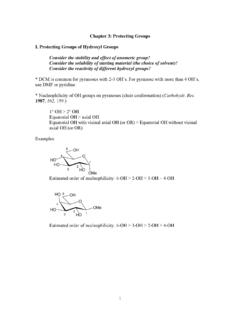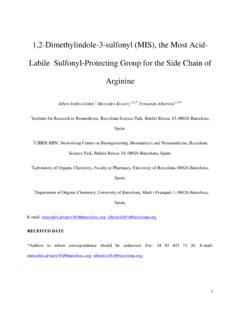Transcription of New Methods in Peptide Synthesis. Part 111.l …
1 Org. 1191 New Methods in Peptide synthesis . part Protection of Carboxyl group By G. C. Stelakatos, A. Paganou, and L. Zervas For the protection of the carboxyl group of amino -acids during Peptide synthesis , the acid -labile diphenylmeliiyl ester group was used. N-Trityl- ( , triphenylmethyl), N-formyl-, or N-o-nitrophenylsulphenyl- amino - acid diphenylmethyl esters were converted by known Methods into the corresponding ester hydrochlorides. The deblocking of the carboxyl group was accomplished either by the action of dilute solutions of hydrogen chlGride t : hydrogen bromide in nitromelhane, by trifluoroacetic acid , or by catalytic hydrogenolysis.
2 The acid -stable phenacyl ester group permitted the preparation of the corresponding amino - acid ester hydro- bromides by treating N-benzyloxycarbonylamino- acid phenacyl esters with hydrogen bromide in acetic acid . Easy alkyl-oxygen ester fission was brought about by sodium thiophenoxide. IX continuation of our attempts to del-elop more refined Methods for use in Peptide synthesis , the problenz of the protection of the carboxyl group of E- amino -acids has been investigated. The protecting groups more commonly used so far have been limited to the ethyl,3 ben~yl,~>* or t-buty15 ester groups.
3 The use of methyl or ethyl esters has the advantage of permitting the lengthening of the Peptide chain at the amino -end regardless of the method used for the temporary protection of the amino - , group . Nevertheless, the main disadvantage of such a method is that hydrolysis of esters of long Peptide chains, or of Peptide esters bearing alkali-labile protecting groups in their side-chain is difficult. Benzyl esters are better because the carboxyl group can be unmasked by catalytic hydrogen~lysis,~.~ provided that the Peptide chain is not too long, and does not include sulphur-containing amino -acids.
4 In the latter case, t-butyl esters are more valuable, since the t-butyl group can be easilv removed by hydrogen chloride in non-polar solvents, or by treatment for a few minutes with trifluoroacetic However, the use of t-butyl esters is restricted by the nature of the N- protecting group ; since benzyloxy- carbonyl or other groups removable by hydrogenolysis are usually eniployed to protect nitrogen, disadvantages similar to those described for the benzyl ester group are again encountered. However, after the introduction of the sulphenyl method ~7 for the N-protection of amino -acids, the t-butyl esters became, in our opinion, * During the preparation of tritylamino-acids we have ob- served the formation of trityl esters, e,g.
5 , trityl-L-alanine trityl ester; cf. ref. 2a. Similar observations have been reported by H. Block and M. E. COX,^ as well as by G. Amiard and R. A. Vollmar and 31. S. Dunn (cf. ref. ) have reported that aqueous solutions of the hydrochlorides of amino - acid t-butyl esters become acid after several hours. Allrenes and t-butyl alcohol are among the products. part 11, L. Zervas and Ch. Hamalidis, J. Awzev. Chenz. Soc., 1965, 87, 99. 2 Presented in part at the Fifth and Sixth European Peptide Symposia: !fz) E. Gazis, B. Bezas, G. C.
6 Stelakatos, and L. Zervas, peptides : Proceedings of the Fifth European Symposium, Oxford, 1962, ed. G. T. Young, Pergamon Press, Oxford, 1963, p. 17; and (b) E. Gazis: D. Borovas, Ch. Hamalidis, G. C. Stelakatos, and L. Zervas, peptides : Proceedings of the Sixth European Symposium, Athens, 1963, cd. L. Zervas, Pergamon Press, Oxford, 1966, p. 107; (c) cf. ref. 30c irf,the review by H. D. Law in Progress in Medicinal Chemistry, ed. G. P. Ellis and G. B. West, Butterworths Scientific Publications, London, 1965, vol. IV, p.
7 86. more important, since a step by step lengthening of the polypeptide chain at the amino -end proceeds readily without any danger to the t-butyl ester group . An ideal protection of the carboxyl group could be offered by the trityl (triphenylmethyl) because trityl esters are selisitive towards Far this reason, we tried to prepare amino - acid trityl esters 1);: removing selectively the N-trityl group from the COTIT- sponding N- tri t ylarnino- acid trit yl esters, * but un - fortunately only the glycine derivative could be 50 obtained.
8 This ester hydrochloride (I) is decomposed almost quantitatively in methanol or water-dioxan t solutions, after standing at room temperature for many hours ; methyl triphenylmethyl ether and triphenyl- methyl alcohol are formed, respectively, besides glycine hydrochloride. The rate of cleavage of the trityl ester group is accelerated by raising the temperature ; heating for 1 min. at about 100 is sufficient quantitatively to remove the ester group . Ph,CCI I mol. HCI Ph, *C02H 4 Ph, *CH,CO,*CPh, ____dF acetone-wzte r Et3N H20 HCI* *CPh3 -W HCI, *COZH -j- (CH 30 H 1 +- Ph,C-OH (Fh, *CH,) A detailed account for the preparation and use of amino - acid esters is provided by J.)
9 P. Greenstein and If. Winitz, Chemistry of the amino Acids, John TViley and Sons, Inc., New York, 1961. 4 M. Bergmann, L. Zervas, and L. Salzmann, Bev., 1933, 66, 1288. 5 (a) R. W. Roeske, Chem. and Ind., 1959, 1121; G. \I-. Anderson and F. M. Callahan, J. Amev. Chem. Soc., 1960, 82, 3359; R. Schwyzer and H. Kappeler, Helv. Chinz. Acta, 1961, 44, 1991 ; F. M. Callahan, G. W. Anderson, R. Paul, and J. E. Zimmerman, J. Amev. Chem, Sac., 1963, 85, 201; R. Roeske, J. Ovg. Chem., 1963, 28, 1251; (b) A. Vollmar and M. S. Dunn, ibid., 1960, 25, 387.
10 H. Kappeler and R. Schwyzer, Helv. Chim. Acta, 1961, 44, 1136. L. Zervas, D. Borovas, and E. Gazis, J. Anzev. Chew?. SOC., 1963, 85, 3660. 8 M. Gomberg and G. T. Davis, Bey., 1903, 36, 3924; G. S. Hammond and J. T. Rudesill, J. Amer. Chern. Sac., 1950, 72, 2769; C. A. Bunton and A. Konasiewicz, J. Chem. Soc., 1955, 1354; K. D. Berlin, L. H. Gower, J. W. White, D. E. Gibbs, and G. P. Sturm, J. Org. Chem., 1962, 27, 3595. H. Block and &I. E. Cox, peptides : Proceedings of the Fifth European Symposium, Oxford, 1962, ed. G. T. S oung, Pergamon Press, Oxford, 1963, p.









